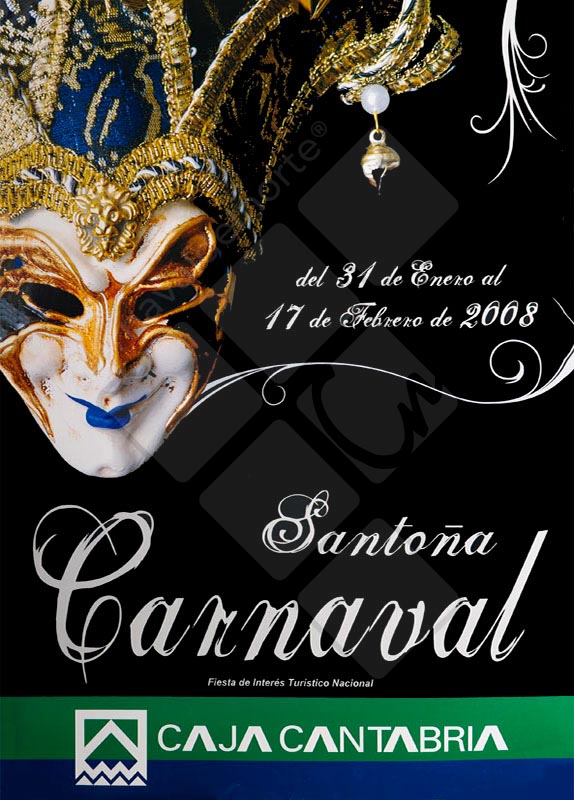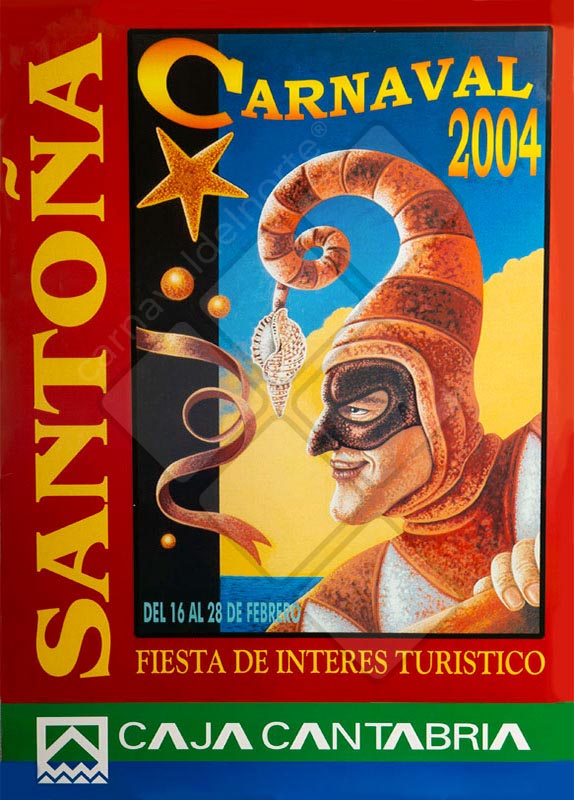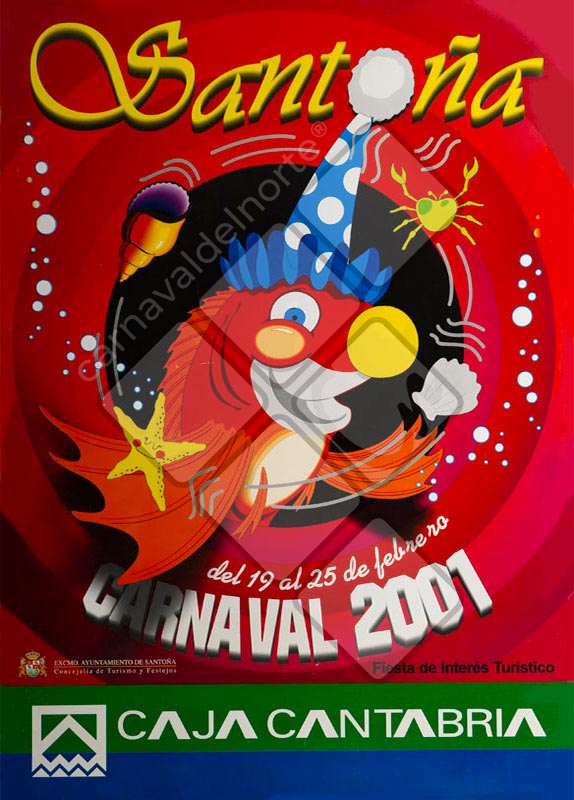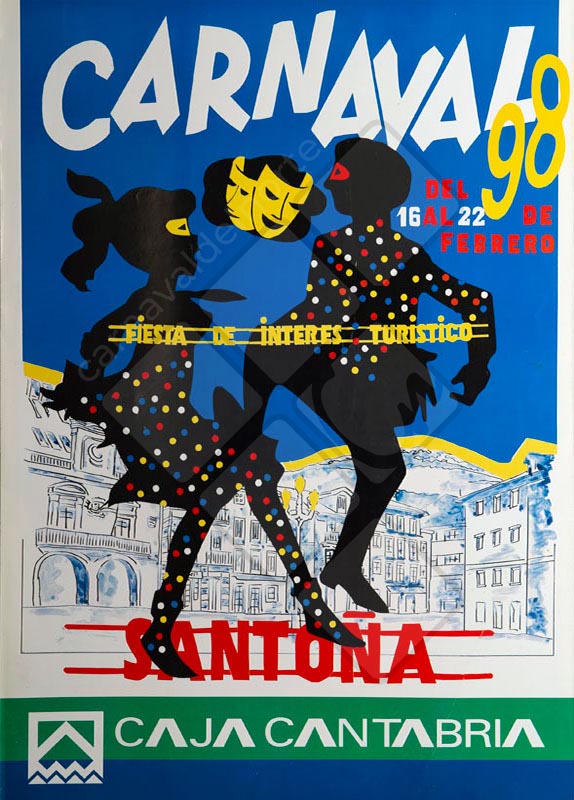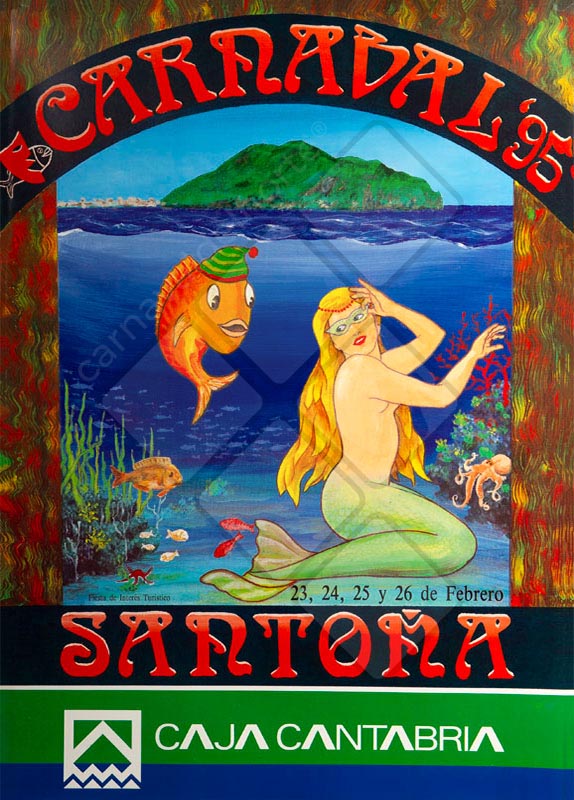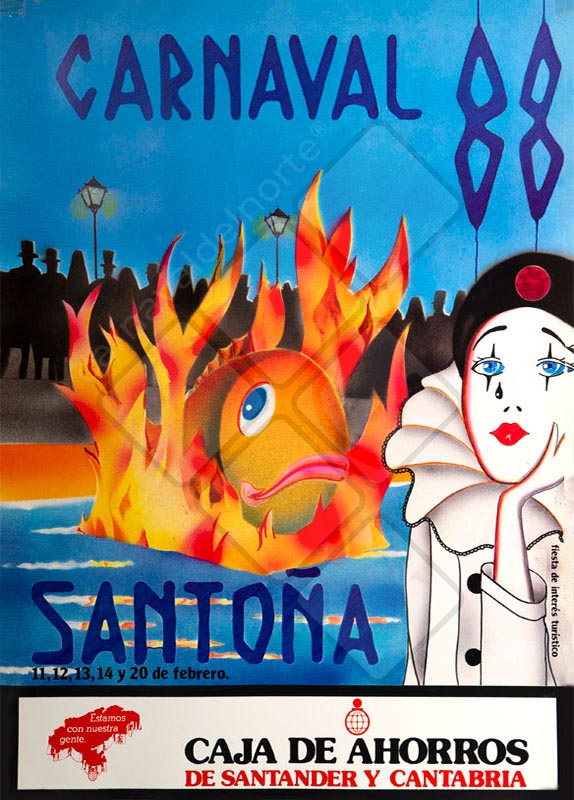The magazine SANTOÑA, in its September 1963 edition, included an article written by the teacher of the "Manzanedo" secondary school on the popular poetry of Santoña, in which we can read part of the lyrics of the murga "los parrandistas" from 1934, "el Judgment en el fondo del mar" (the Judgment at the bottom of the sea).
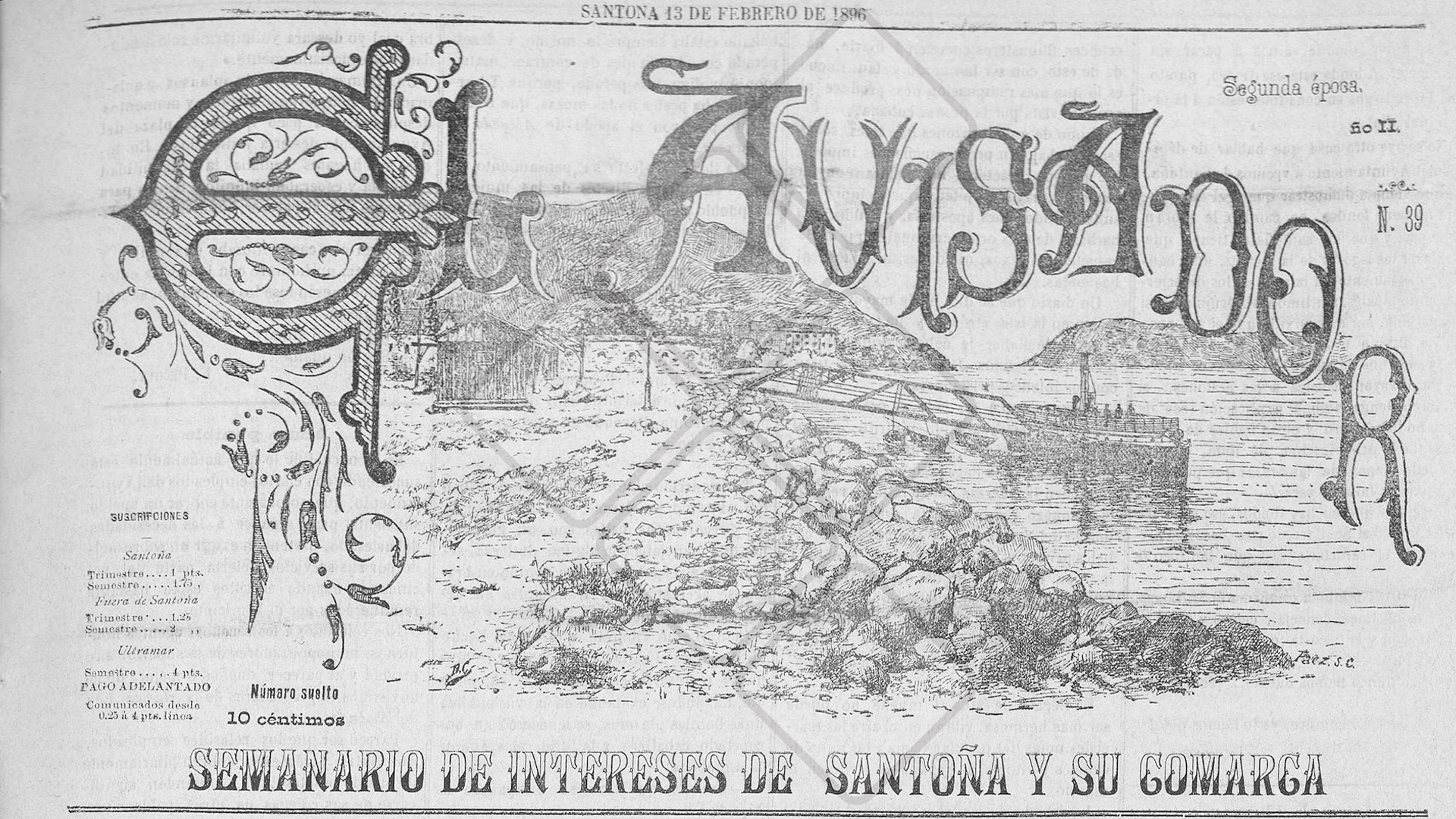
The origins of the Santoñés Carnival are unknown but from the data that we have been collecting during these years, we have the following “journalistic” confirmations:
- In the newspaper "The Correspondence of Spain" published in Madrid on March 3, 1881, the following news appeared:
n the same press release, he already talks about piñata Sunday. For which another dance was being prepared.
In the successive years we can already find different news about the Santoñes and Studentinas Carnival (what today we call
murgas), in the newspapers of the time such as "El Correo Cantabria", "La Atalaya", "El Isleño", "El bien Publico ”And“ El Avisador ”
- On January 18, 1893 "El Correo Cantabria" published:
- In 1894, the news stood out in various newspapers, not only in Cantabria, but at the national level, such as Mahón's “El Bien Publico”
titled the news as “Murderous Soldier” in which he recounted what happened on Carnival night in Santoña:
- On February 13, 1896, the newspaper "El Avisador" published:
Carnival as a popular festive manifestation has roots that are difficult to pin down, because the memory by oral transmission has been lost over time. In this sense, in Santoña there are no written records beyond those that appear in local periodicals from the end of the last century, such as the "Eco de Santoña" which describes the carnival of 1892 as follows:
"They say that carnivals are in the doldrums,
it is not true, because it seems to me that they are
even without capes, judging by this year.
Despite being the truly
spring time, there have not reached half a dozen
costumes who have been through the streets of this
village, and all of them have been none that
has attracted attention.
the Choral Society and the military band formed a
estudiantina that caught enough attention and
was widely applauded that estudiantina, for
reasons We do not know he could not go to Castro,
as we had announced
The masked balls of the Liceo Casino,
Juventud Santoñesa and La Peña society,
They were very animated, as well as those of the
Spanish café and José Bonet.
On Piñata's day, the Orfeón toured the streets of
the town. And until another year. "
Signature: Mask.
As is evident from this and other references from the first years of the 20th century, at that time the carnival and its costumes clung to the halls of the town and although it was a festive period of time celebrated in large numbers by people of all conditions social, it had no street character. But let's see how the party passed in that month of March 1892 in the different rooms of the town:
"THE CARNIVALS OF SANTONA AT THE CASINO LICEO"
"Everything does not have to be City Hall, sometime I have to be a magazine rack, even if I do it wrong. And without preamble I will tell you what I saw.
In the first dance a lot of animation, a lot of pretty faces, good music, few masks and less jokes. The second I did not know as soon as I entered the room. Antithesis of the previous one, everything was caps of whimsical shapes and cuts, there were cool ones that looked real, but the most notable was the magnificent collection of masks that caught the attention of Terpsicore fans for the beauty and beauty of their faces, and for That everything contrasted with the night before there were far superior jokes and of course, the colors came out to our faces. I will not mention the girls who attended the dances because I would have to list all the beautiful Santoñesas who wore all their beauty and elegance in those dances ... To finish, I send my congratulations to the President of the Casino from these columns,
I hope that it will soon be very crowded on the right track so that young people can spend evenings as delicious as those of these previous nights ".
"THE CARNIVALS IN SANTOÑESA YOUTH"
"The dances held in this recreation center on Carnival Sunday and Tuesday and Piñata Sunday have truly been magnificent; a lot of animation, a lot of hustle and bustle and many masks.
But the Piñata dance has been the« non plus ultra »of all those celebrated in this society, what beautiful women! what elegant costumes ... what «maremagnum.»
If I were to describe all the costumes I would need all of The Echo, but I also do not want to overlook some who truly called the
attention. I saw one of the reapers ... which was the sea, others of letter machines, Jerez bartenders, cool ones, etc. Abbe and Enrique III who will not let me lie, as well as the costumes of Rigoleto and Sergeant Federico that they liked a lot.
There was also a large assortment of hoods and cool with more or less grace, in short a complete medley.
At ten o'clock the dance began, and at eleven it was not possible to take a step in the room, and the couples were fighting while dancing. ..and at three in the morning it ended in the middle of the greatest animation. As we left the room with a sad heart for having finished the carnivals, we couldn't help but exclaim. And now for another year! ".
In the early years of the 20th century, carnivals continued to be based on masked balls, animated by orchestras playing waltzes and polkas until the wee hours of the morning. In the year 1907 those celebrated in the Círculo Artesano stood out for their animation and attendance.
Masks and costumes were very important in the dressing of those days of Carnival and Piñata Sunday, which were awaited year after year with real impatience, to the point that young people were able to anticipate events by up to a month at a time. official calendar, as happened in the masquerades of late January 1909.
So much interest in disguise materialized in the development of a trade in cardboard, percaline and satin masks, noses with mustaches, confetti, streamers, tambourines for students, bells, caps for clowns and other characteristic articles of those dates, which in those days Circumstances monopolized the Meléndez printing press. On the other hand, during the day and only when the weather allowed, the Regiment band, the popular band and the municipal tambourine enlivened with their music those afternoons in the Plaza de la Villa and La Alameda, complementing the vertigo of the nocturnal dances celebrated especially in the Santoñesa Youth.
In 1910, during the three days of the carnival, the adverse weather conditions of the previous years were repeated "a lot of water in the clouds, more mud in the streets than water in those and a handful of carefree people in disgusting costumes and a mask, who were entertained in annoying others, it was the show these days ... "
Once again the animation focused on the ballroom dancing, in which clever masks and flashy costumes were displayed. On some occasions, the transformation of identity through disguise came to be rewarded to encourage the originality and spectacularity of the models, in order to favor the influx of participants and the general public. Thus, the Santoñesa Youth in 1910 "offered luxurious prizes for the best presented masks. In search of this, there were masks in great numbers and luxuriously attired"
Reviewing those carnivals, in different years, we can see that the types of costumes were varied, of bundles of merchandise, motorists who "danced (in 1907) at the speed of a Panard of forty horses", of reaper, abbot, card thrower , Enrique III, "Rigoleto", from Jerez, chulas or "Sargento Federico", a popular character at that time.
Those who preferred to hide their identity completely, in order to be able to make jokes with greater impunity, were placed under hoods of various invoices and ornamentation, which over the years were being replaced by the so-called "funeral raincoats".
In any case, in the words of the chroniclers of the moment, young people greatly enjoyed during those celebrations, which they later narrated in detail in their articles, not losing detail of all the events that occurred during the evenings, that if, without discovering the identity of the protagonists.
On the other hand, jokes and gossip accompanied in the course of those ballroom parties and, if not, there are some samples ...
... "There we learned strange things said with a veragüean intention, by a certain covered up to a discreet chicken, the kind that, according to the vulgar saying, takes them gropingly and kills them silently; that is, without improper praise of those who dress by the feet . Very good child X ... and later your mother will say that you are a saint !. How little the poor lady knows certain walks !.
Another vaporous mask of pink and airy suit gave us the content of a letter from a certain "Butterfly", of high stature who was teased with said letter, suspecting if she would be the addressee, because she knew it by heart. We do not know what judgment the tease would form; but apparently she liked the guasita, as she followed it with interest ... "(Eco de Santoña March 12, 1908).
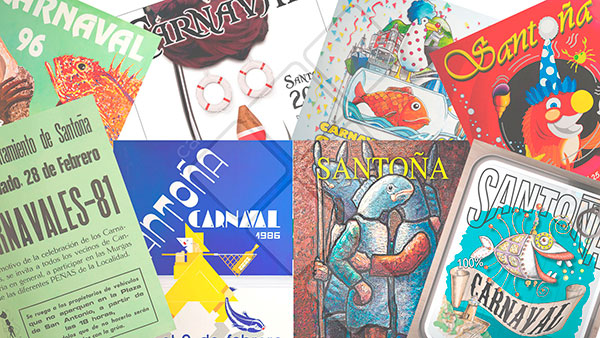
Below we show you all the posters announcing the Carnival of Santoña since its first edition in 1981.

In 2008, ALADIERNO magazine, a magazine offered by Iberia airline to its travelers, included a report on the Santoña carnival entitled "The Santoña carnival, a town of artists" and in it we could read the following:
"... Declared a Festival of National Tourist Interest in 1985, the Carnival of Santoña offers a varied and fun offer of entertainment, led by internationally known murgas, ironic popular verses created and sung by hospitable Santoñeses. The acts have a varied program that runs from January 25 to February 17,
Another of the Fundamental pieces of the carnival is the work of José Carlos Juncal lbaceta who in 1981, from a murga, created the script for the representation of "The Judgment at the Bottom of the Sea - which we can all enjoy today and, as he says , - is nothing more than a metaphor in defense of life and the environment ".
Thus, what at first was just a small initiative that got the whole town out in disguise in 1981, became in just one year the perfectly structured party we know today: Parade, costume contest and " Trial in the bottom of the sea",
Throughout the years the Santona carnival has been perfected, day by day, thanks to the efforts of the citizens of the town, making this party a benchmark among the carnivals that are celebrated throughout the Spanish geography.
THE REPRESENTATION OF "THE JUDGMENT AT THE BOTTOM OF THE SEA"
The plot of this work is based on the forbidden love of a sea bream for a mermaid. He manages to kidnap her but soon the fish from the sea manage to catch him and thus begins a trial in which all the aquatic inhabitants present their version of the facts.
All the characters are present at the trial: from the defense attorney, played by a "salvareo" to the attorney, who is a flying fish or the "sole" acting as beadles.
The trial is structured in three parts: In "the promenade of the prisoner", the sea bream is led through the streets of Santoña until it reaches the Plaza de San Antonio where the trial is staged at the Bottom of the Sea before Neptune, king of the seas, and fish and mollusks. Although the sea bream is acquitted, it dies of love when knowing that it is rejected by the siren, and that is when the parade that accompanies the sea bream to its last resting place: the bay of Santoña begins.
The entourage is made up of numerous fish and neighbors mourning and saddened by the death. This march continues to El Pasaje where the sea bream is deposited in a raft that is set on fire. The ashes of the sea bream personify the figure of the Santoña carnival.
Another of the sections that the article referred to is that of the murgas, the parades and the rest of the days of the Santoña carnival and they described it as follows:
THE MURGAS OF SANTOÑA
One more incentive of this carnival are the murgas. In Santoña, adult and children's costumes prepare throughout the year to delight anyone who comes to the town during carnival.
The rehearsals begin very early, in October of the previous year, and although in principle they only meet on weekends, from January the meetings to rehearse the songs take place during more days of the week.
In the costume contest, four concepts are scored:
- The scenography: that is, the decoration used to support the murga.
- The letter and criticism.
- The song: the quality of the murga's interpretation,
- The staging.
COMPETITION STRUCTURE
The structure of the murgas contest is as follows: In the first preliminary: the weekend of January 25, 26 and 27, the murgas who appear in the contest perform their murga, which will last about 20 minutes, The following On the weekend, on the 28th, 29th and 30th, the second preliminary takes place, in which the same murgas interpret again the songs that may suffer some alteration in any of the parts that make up the murga. Of this second preliminary, 5 murgas remain and on January 31 the winning murga is ruled.
The murgas are structured in five parts: presentation, two pasodobles, chorus, a potpourri and the ending.
The little ones also participate in the popular rnurgas contest, with its presentation on January 26 and its final on February 1.
GREAT PARADE OF GARNAVAL
The Grand Parade for the elderly will be held on February 2 and in it about 12 groups participate year after year, while the children have their big day the day before, on February 1,
As every year, the Grand Parade will feature a costume contest whose prizes will be awarded once it is over, at 9:30 p.m.
The carnival culminates on the weekend of February 15, 16 and 17 with the Medieval Market and the main celebration on the 16th of the villager's day.
Throughout the weekend the Plaza de San Antonio is transformed into a medieval forum and the trades and customs of the time invade the streets of Santoña,
On Villager's Day the peñas, murgas and groups of the town go out through the streets pulling a cart specially enabled for that day with a griddle in which sausages, blood sausages, ribs and peppers are cooked that they share with whoever they meet. his step.
Source: aladierno- airnostrum magazine




































